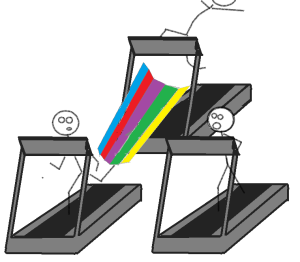Be excessively nice to each other.
–Stephen Fry
Which is a stronger motivating tactic, fear or love?
I can recall several teachers, mostly in middle school, who were excellent purveyors of fear-fed encouragement. One was prone to throwing desks in her terrifying fits of frustration. Another teacher – a math genius who apparently couldn’t fathom why a student lacked the gift of telling when one train travelling 295 mph would pass the other if the other train was actually a hyena who had just received an accidental pap smear and was late for a meeting in Chicago – would employ the brilliant tactic of asking why said student couldn’t understand math.

One train is heading east at 295 mph, the other at 200 mph, the one from Chicago, the other from New York, the former trav–DERRRRRP
For me, teachers are either remembered for being inspirational or terrifying, and the latter type has been pretty successful at convincing me to forgo Zelda and trudge through the painful slop that is Shakespearean literature.
That being said and as much as I have admired such wrath-incurring, desk-propelling tyrants, I find that the positive always outvalues the negative.
I find it’s the same in fueling a run with anger and fear versus one with positive thoughts and happiness.

An oldie, but a goodie, from my earlier blog
As an English teacher, I strive to put my students at ease, elicit any efforts no matter if the answers are wrong or right, and genuinely praise them when those answers happen to be right. With some, I’m simply happy that they’ve chosen to speak. After all, I do work for an English conversation school.
On the other hand, as a person in general, I’m not exactly bursting with sweetness. Coworkers, friends, roommates – forgive me.
In the classroom, though, I’m a confetti-filled, carousing (and another hyphened, three-word c word my British coworker often enjoys saying) crowd pleaser, albeit no sycophant. While I admittedly enjoy taking my teaching tactics from Quite Interesting (bless you, Mr. Fry), I’ve often tried to style my teaching after a few of my more positive former teachers both in high school and at university.
Madame H., as I’ll call her, was my first true language teacher. Nearly every week of my freshman year of high school, the tiny French classroom of six students (the remaining entire grade having enrolled in Spanish) smelled of crêpes, cheeses, and whatever French treat Madame had us prepare that day.
While I was happy my best friend also decided to take the class, Madame was the main reason I chose to continue learning the language; she made every class fun and interactive, yet she expected much from our studies and therefore commanded our respect.
I had similar teachers in other subjects before and after Madame. Despite my poor math skills, I surprised myself after doing quite decently in AP Physics, thanks to an enthusiastic and persistent instructor. My poor piano teacher, probably the most persistent and patient of them all, was a constant purveyor of encouragement, even when she knew I hadn’t practiced much since our last lesson.
There are many studies on the effects of positive and negative, stick or carrot, methods of teaching, but, as those studies and my own experiences have attested, the carrot seems to be the healthier choice. Though, as an easily flattered egoist, I’d prefer the crêpe.

